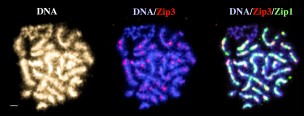Professor MacQueen discusses her research on meiosis.
As far as our genetic makeup is concerned, we are all composed of two halves: one from Mom and one from Dad. At the molecular level, this is made possible by chromosomal dynamics in meiosis.
Amy MacQueen, Assistant Professor of Molecular Biology and Biochemistry, and the members of her lab hope to better understand the molecular basis of this genetic dance.
“Meiosis is the cell cycle division process that is specialized to [first] bring homologous chromosomes together, and then pull them apart, so that they are parsed precisely into daughter cells, such that each daughter cell gets the proper number of chromosomes,” MacQueen said.
MacQueen went on to explain the complexity of meiosis.
“The problem is this: You’ve got two sets of chromosomes, one set you got from your mom, one set you got from your dad,” she said. “Mom gave you a chromosome number one and dad gave you a chromosome number one. Those are homologous chromosomes.”
When reproductive cells—that is, eggs (or oocytes) and sperm (or spermatocytes)—are made, these homologous chromosomes must be separated. Each resulting reproductive cell, or daughter cell, must then end up, in turn, with one copy of each chromosome.
“In order for those chromosomes to precisely march into the proper reproductive cell, so chromosome number one only goes into a cell that doesn’t already have a chromosome number one in it, the two chromosome number ones that have to separate themselves have to be together at some point,” MacQueen said. “They have to find each other and attach. It’s that attachment that allows them to move away from each other.”
The failure of homologous chromosomes to properly pair up and segregate results in “aneuploidy,” a condition in which a cell has too many or too few chromosomes. Aneuploidy plays a role in infertility, developmental defects such as Down’s Syndrome (also referred to as Trisomy 21, as the disease results from three copies of chromosome 21), and even cancer, in which the parent cells, though passing on a complete set of chromosomes to daughter cells, reproduce uncontrollably.
The MacQueen lab seeks to investigate the molecular mechanisms that drive the proper pairing and segregation of homologous chromosomes so that scientists and doctors can better understand why this process sometimes goes awry. But how is this intricate process studied?
“We take a genetic approach to almost everything,” MacQueen said. “We try to figure out whether a protein or a region of a protein might be involved in the process by altering the gene that encodes for that protein or encodes the region of that protein, and then looking [to see] what happens. So it’s just like tweaking different parts of a radio to find out what part controls what. Tinkering like that is just fun. It’s very exploratory and sometimes it’s hypothesis driven, but often it’s just exploratory, and you wait and see what you get.”
In order to adequately see what is happening on the cellular level, one uses a high-resolution light microscope. Similar to the ubiquitous prop that can be seen on a tabletop in any movie or TV show featuring a scientific element, these advanced microscopes are used to observe structures on the micron (one-billionth of a meter) scale.
To visualize even smaller objects, a structured illumination microscope can be used to observe beyond the resolution limits that normally constrain light microscopy. It is perhaps these technologies that instill fascination in the minds of chromosomal researchers like MacQueen.
“Chromosomes are very alluring,” she said. “They’re really pretty to look at, and we actually can see these chromosomes [in a microscope]. If we couldn’t see these chromosomes, I’m not sure I would enjoy it as much. But since microscopy [and cytological techniques are] becoming more and more powerful, and we can localize a higher number of proteins, our toolbox is getting bigger. It has not become boring, that’s for sure.”
In addition to being enjoyable on an aesthetic level , this viewing process is one of MacQueen’s greatest passions.
“When you have a good day,” she mused, “looking at chromosomes is just like… seeing is worth everything.”
What’s the take-home message here?
“The bottom line is: I’m a cell biologist and a geneticist, and one of the biggest mysteries that has always been surrounds how chromosomes segregate themselves properly when reproductive cells are made,” MacQueen said. “So to this day, we still don’t really have a good idea, or a very detailed model of the process by which chromosomes are able to parse properly, to separate properly and segregate properly, and that’s the reason I study it. It’s just cool, because it’s really a black box.”
MacQueen remarked that the work she does in her lab is propelled by her love for science.
“I do this because I want to know!” she said. “I love figuring out stuff that people don’t know. That’s what I love about science—that jaw dropping moment where you know something that nobody else knows. And that’s what drives us. That’s what really drives us.”

Comments are closed